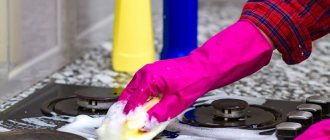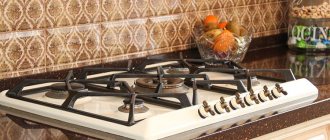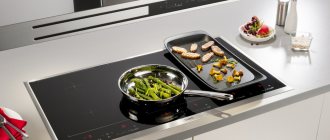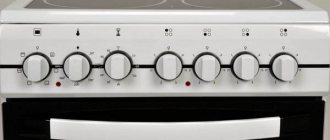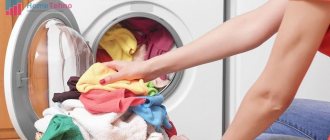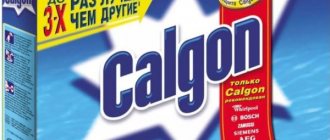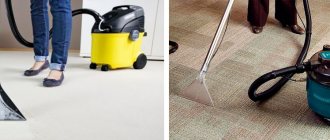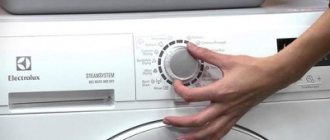Share on social media networks:
There are a variety of electric stoves on the modern market that are used for cooking. One type of kitchen equipment is stoves with glass-ceramic work surfaces. Glass ceramics is a new material in the manufacture of such devices, but has already gained particular popularity, because these models instantly heat up and cool down quickly. Electric stoves with glass-ceramic coating are indispensable assistants in the kitchen. In addition, they have a magnificent design and impressive appearance, and a special scraper will help preserve the original appearance of household appliances for a long time. In this article we will look at a scraper for cleaning glass-ceramic stoves and learn the basic rules for its use.
Scraper for glass-ceramic hob - what is it?
To clean a glass-ceramic hob, a scraper is used, which consists of the following elements:
- A handle that is made of metal or durable plastic.
- Sharp blade made of stainless steel. There are two types - fixed or movable, which can be extended.
- A screw that is used when replacing the blade and for fixing.
Most often, the scraper is made of steel with removable blades. In addition, there are cheaper tools that are made from plastic, but such scrapers are less strong and durable. Many well-known manufacturers, such as Whirlpool and Electrolux, make their own scrapers and replacement units for dull blades.
Important! Scrapers with a plastic handle and a fixed blade have a much shorter service life than tools with a steel holder and a movable blade.
Why a scraper?
Even with careful cooking, a situation may arise when compote or broth splashes. As a result, the electric stove has an unsightly appearance, and the work surface is dirty with sweet and greasy stains.
To remove this type of contamination, you cannot use conventional cleaning products, as well as hard sponges, as they can only worsen the situation.
To clean the dirty surface of a glass-ceramic stove, use a special scraper, which helps to avoid minor scratches during the cleaning process.
The use of such a convenient tool allows you to:
- effectively remove dried dirt;
- It’s great to eliminate all burnt-on contaminants, especially if the electric stove is still warm;
- do not leave small scratches on the working surface, since it is possible to adjust the inclination of the blades;
- the blade can be replaced;
- working blades are absolutely safe during use;
- The scraper for cleaning glass ceramic hobs is dishwasher safe.
The kit for cleaning glass-ceramic surfaces contains additional blades that serve to replace already dull ones.
Purpose of the cleaning knife
Due to the fact that the surface of a glass-ceramic hob is unusually capricious, the use of conventional cleaning products is impossible. The material reacts sharply to any abrasive. Even a regular brush with stiff bristles can leave scratches on the surface of the stove.
The purpose of a cleaning knife is to remove burnt food and other traces of human activity during the operation of kitchen appliances.
The scraper for glass ceramics does not leave marks after its work.
The cleaning tool allows you to:
- remove old, dried dirt;
- remove recent dirt while the stove is still warm;
- Do not leave scratches on the surface of the stove.
The latter is achieved by the ability to adjust the angle of the blade relative to the working surface.
How to use?
To clean the working surface of a glass-ceramic hob, you must:
- Moisten a clean flannel cloth with a special glass ceramic cleaner and wipe the working surface of the electric stove.
- Wait some time until the cleaning agent dries.
- For the cleaning process, it is necessary to install the scraper at an angle of thirty degrees to the working surface and make cleaning movements back and forth.
- After cleaning is complete, wipe the working surface of the glass-ceramic hob with a clean, soft cloth.
Important! If you had to spend a lot of time and put in a lot of effort during the cleaning process, this indicates that the scraper is in the wrong position or that a dull blade was used, which requires replacement. When used correctly, such a tool will very quickly eliminate burnt food residues and other contaminants.
To facilitate the process of operation and clean the glass-ceramic hob from contamination, you must adhere to the following recommendations:
- If sugar is burnt, you must immediately clean the work surface before the electric stove cools down.
- When removing a hard and old stain, you can apply olive oil and cover with a wet cloth for ten minutes, which will soften the stain and simplify the cleaning process.
- When removing stubborn stains, you can use a watery paste made from baking soda. To do this, treat the stain with this product and leave it for a few minutes, after which we clean the stain from the electric stove. Next, remove the remaining baking soda and dirty components with a soft sponge. If this procedure does not help, then you can add a little lemon juice to the baking soda paste and leave for ten minutes.
- When systematically cleaning the working surface of an electric stove with glass ceramic cleaning products, a protective film is formed.
- Heating the working surface of an electric stove promotes a better cleaning process.
- The use of a special scraper for glass-ceramic surfaces extends the life of electrical equipment.
- It is necessary to use the glass ceramic scraper at a slight angle to the working surface of the glass ceramic hob.
- To replace a worn blade, you need to unscrew the fixing screw, replace it, and then tighten the screw back.
- To increase the life of the scraper, you should always close it with a lid.
Instructions for using the tool and additional recommendations
To clean a glass-ceramic oven you need:
- Apply a special glass ceramic cleaner to the flannel. Rub the surface of the stove and wait a while.
- Maintaining an angle of inclination of the scraper blade of 30 degrees relative to the plane, make forward and backward movements.
- After all dirt has been cleaned, wipe the surface with a soft cloth.
If the stove is still warm, removing dirt is faster and easier. And if you regularly use products to care for glass ceramics, a protective film will form on the surface. Together with the use of a scraper, these means extend the life of such equipment.
What products can be used to clean a glass-ceramic hob?
To clean the contaminated surface of a glass-ceramic stove, it is strictly forbidden to use:
- sharp knives and other pointed objects;
- steel wool, harsh sponges, rough brushes;
- abrasive cleaning agents;
- aerosol and stain removers intended for ovens;
- regular dishwashing detergents, since after using them stains remain that are very difficult to remove.
Important! Do not wipe the glass-ceramic surface with a sponge used for washing dishes, since residual detergent and remaining grease on the surface of the sponge create a thin layer that burns out when heated. As a result, the working surface of the electric stove loses color, stains form on it, which are quite difficult to remove.
Unsightly stains left by splashes of grease and water greatly deteriorate the appearance of an electric stove. To remove them, you can use products that are specifically designed for glass-ceramic surfaces. There are difficult cases when it is necessary to use preparations that are used to care for steel.
Important! All products are applied to a completely cold work surface.
To clean a glass-ceramic hob, you can use the following methods:
- use window cleaner;
- Each apartment has baking soda, the use of which allows you to clean the capricious surface of the glass-ceramic stove;
- the presence of limescale can be eliminated using a weak solution of vinegar.
General recommendations
It is not recommended to wipe the surface with a sponge that was previously used for plates and pots. The remaining thin layer of fat from the surface of the sponge will create a thin film on the surface of the slab. When heated, it will burn out, the working burners will lose color, and stains will form on them, which are very difficult to remove. Unsightly stains can only be removed with expensive steel care products.
The following types of cleaning agents can be used on glass-ceramic surfaces:
- for glass;
- vinegar;
- soda.
In order to preserve the original beautiful appearance of the surface longer, you must follow the mandatory rules associated with caring for the stove.
- Regular surface cleaning. The stove should be cleaned immediately after cooking.
- Avoid the use of potent drugs. Stain removers and universal products are unlikely to be suitable for glass ceramics.
- If you plan to thoroughly clean a heavily soiled surface, first remove food residues with a scraper, then apply a cleaning liquid, rub it with a rag, and only then wipe the surface dry.
To avoid any damage to the surface, use only suitable cookware for your stove. Flat and level bottoms of pots and pans will ensure a better cooking process.
When you turn it on again, you need to make sure that there are no food residues on the bottom of the pans or the surface itself. Burnt food will be difficult to remove from the surface. Plastic and foil will cause particular harm to the stove. If these components get on a hot surface, they will melt and the substances will be difficult to remove even with a scraper. This glass ceramic tool can be used to clean stainless steel pots and pans.
To learn how to choose the right scraper for glass-ceramic stoves, see the following video.
Rules for caring for glass ceramics
Glass-ceramic stoves are made of durable and reliable materials, so they cope with all tasks perfectly. Timely cleaning of the stove from dirt using a glass ceramic scraper will help extend the service life and maintain the shine of these hobs.
A few basic rules for care:
- The surface must be cleaned regularly, preferably after each cooking process, and the use of abrasive cleansers and scratching sponges is strictly prohibited.
- Do not use strong detergents such as stain remover, oven cleaner and all-purpose cleaners.
- To thoroughly clean the stove, you must first remove food residues and heavy dirt using a scraper or cleaning sponge. Next, you can apply a special liquid for glass ceramics to the cooled surface and rub it with a clean rag or paper towel. Upon completion of the process, you need to wipe the stove with a wet cloth and then wipe it dry.
- The diameter of the frying pan or pan must match the size of the burner.
- It is necessary to use dishes with a smooth bottom to avoid various damages.
- During the cooking process, hot cookware should stand flat and even on the cooking surface, since this way the heating process occurs better.
- The optimal thickness of the bottom made of steel enamel is considered to be 2-3 mm, and for multilayer stainless steel 4-6 mm.
- First you need to place the dishes on the stove, and then turn on the burner.
- When moving the cookware, it is necessary to lift it to avoid scuffs and scratches on the stove.
- When using a cooled glass-ceramic surface, you must first wipe it to get rid of food debris and small grains of sand.
- If plastic, aluminum foil, or sugar-containing products get on the hob, you must immediately remove these contaminants using a scraper for cleaning glass-ceramic hobs. Otherwise, these substances will begin to melt and damage the stove.
How to clean a hob with a scraper
When cleaning the hob, take into account some features. For example, in some cases you can only work on a completely cold surface.
It is advisable to clean the glass-ceramic panel with a scraper when:
- heavy pollution;
- presence of burnt parts.
In other cases, regular cleaning compounds and a soft cloth will do. If your hob is made of glass ceramics, then during general cleaning use special products suitable for this material. They are distributed over the surface using a microfiber cloth.
Important. Some gels and pastes require leaving on the surface for several minutes, so be sure to read the instructions before use.
If the product forms a film, remove it with a scraper along with the dirt.
Clean only the cooled surface:
- Apply a special cleaning agent suitable for your type of hob to a microfiber cloth or other soft cloth and carefully spread it over the surface.
- Maintain the time based on the instructions for use.
- The resulting film is removed with a scraper - the tool is positioned at an acute angle of 30°. If positioned incorrectly, the panel can be easily damaged.
- Clean the surface using back and forth movements until the panel is clean.
After using the scraper, remove remaining dirt with a sponge and then wipe the surface with a soft cloth.
The scraper is thoroughly washed with warm water; detergents can be used. After this, the tool is dried, otherwise the knives will become dull.
Carefully. If the scraper blade becomes dull, it must be replaced. Otherwise, it will be difficult to use such a device.
The hob must not be cleaned with other sharp objects, otherwise it may be scratched. It is strictly forbidden to remove contaminants:
- sharp kitchen knives;
- steel wool and hard sponges;
- abrasive cleaning compounds;
- aerosols for ovens.
It is not recommended to wipe the surface with a sponge that was used for plates and pots. A layer of fat on it will create a thin film on the hob. When heated, it will burn out, the working burners will lose color, and stains will form on them, which are difficult to remove.
Stubborn stains can only be removed with expensive compounds designed to care for steel. In order for the hob to retain its original appearance longer, you must follow the following rules of care:
- Clean the stove after each cooking process.
- Avoid the use of abrasive compounds and strong chemicals.
- If thorough cleaning is required, first remove food residues from the surface with a scraper, then apply cleaning liquid by rubbing with a cloth. Only after this the surface is wiped dry.
To avoid various damage to the surface, use only utensils that are suitable for your hob - pots and pans with a flat and even bottom.
What to do if the scraper scratches the hob
Clean the surface with a scraper carefully, strictly according to the instructions. But sometimes it happens that when you pick up this tool for the first time, you can accidentally scratch the surface with it.
There are three types of scratches:
- small, when no more than 30% of the coating layer is affected and the shape of the scratch has an acute angle;
- large, when the damage has a depth of more than 30% and the shape of the scratch has an angle of more than 90°;
- deep when scratches are over 50%.
If the scratch goes right through, it is already a crack.
Minor damage is sanded. The process goes like this:
- The burr is ground with abrasive and the corner is rounded. Sandpaper, toothpaste and other fine-grained abrasives will do.
- The surface is sanded with paste. The most common method is felt or GOI paste. In fact, the scratch will remain, but will be less noticeable or completely invisible. Large scratches are treated using the same method, but they will still be noticeable.
Minor scratches can also be “treated” using traditional methods:
- The surface is cleaned of traces of fat and dried.
- Mix toothpaste and baking soda in equal quantities.
- Apply the mixture to problem areas, use a soft cloth to polish in a circular motion, wiping out cracks.
- Use dry wipes to remove any remaining paste and wipe the surface.
You can also use a special Domax product. It contains not only cleaners, but also polishing agents. The product cleanses grease, dirt, soot and removes minor scratches, and forms a protective film on the glass-ceramic panel. To get rid of damage, apply the product to a clean surface and rub away minor scratches with a soft cloth.
To remove deep scratches, use the following method:
- Only the burr is removed with abrasive, without rounding the corners.
- Thoroughly clean and degrease the scratch.
- A special coating is rubbed into it, which has a similar structure to the glass-ceramic coating and has good adhesion to it.
This is interesting:
Rules for installing an induction hob.
What to do with a crack on the hob.
Differences between an induction hob and a ceramic hob.
Popular scraper models
Each manufacturer of household appliances offers in its range of products special care products. So in this case - a scraper for cleaning glass-ceramic hobs is available for sale from all famous manufacturers of hobs.
Scraper INDESIT C00091279 for glass ceramics
This device is most effective when used on a still hot hob, as it helps to better cope with contaminants. Main characteristics of the scraper:
- absolutely safe to use;
- effectively copes with any contamination;
- has an adjustable blade angle, which helps prevent unwanted scratches on the hob;
- The kit also includes a replacement blade;
- iron body;
- made in Italy.
Scraper for cleaning glass ceramics Filtero 203
This device is intended for cleaning glass-ceramic, glass and tile surfaces from burnt and old dirt. The Filtero 203 scraper helps extend the life of the slab as it effectively removes all accumulated grease and debris.
Key Features:
- the product body is made of plastic;
- scraper dimensions: length 155 mm, width 54 mm, thickness 16 mm;
- the blade is made of high-strength steel;
- blade width - 38 mm;
- there is a movable protective plate;
- There is a hole in the handle for hanging the scraper.
Pyramida scraper for glass ceramic surface of electric stove
Main characteristics of this product:
- effectively cleans the glass-ceramic surface from dried and burnt food residues and other contaminants;
- does not leave minor scratches or defects;
- equipped with a comfortable rubberized handle;
- safe during use;
- The kit includes a double-sided blade;
- there is a protective cover for the blade;
Important! This scraper for cleaning glass-ceramic hobs is perfect for any hob.
Glass ceramic care set TOP HOUSE 391435
The modern market also offers entire kits for caring for glass-ceramic hobs. This TOP HOUSE 391435 kit is produced in Germany using advanced technologies and helps to extend the service life of the glass-ceramic stove and maintain its original appearance.
The TOP HOUSE 391435 set includes:
- a scraper for glass-ceramic stoves that effectively removes burnt-on dirt;
- five scraper blades;
- a special napkin, 33x35 cm in size, for cleaning the stove;
- 300 ml of silicone product, which is designed to clean glass ceramics from dirt.
